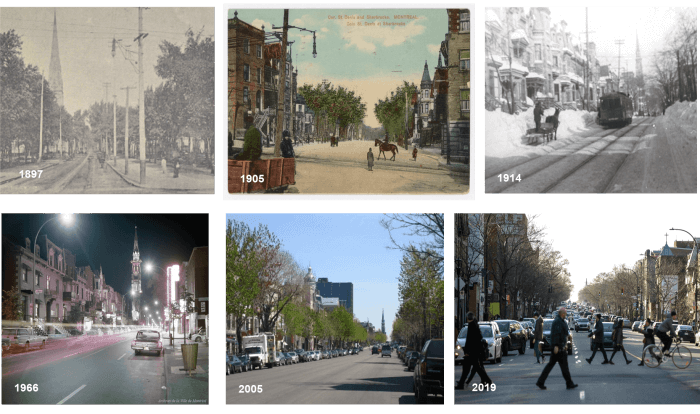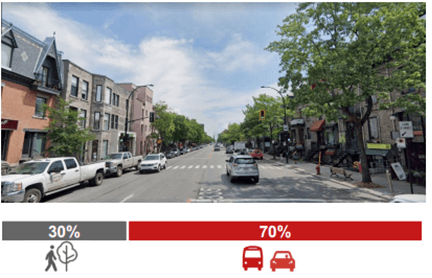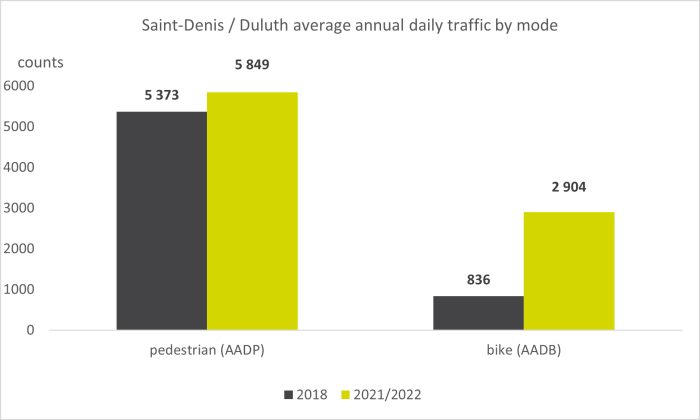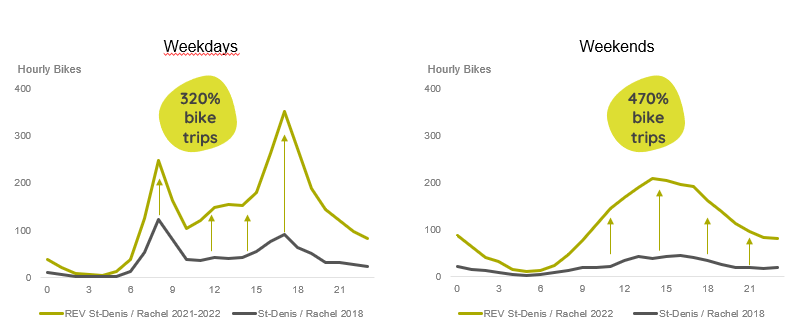St Denis local economy through the ages
A major north-south communication axis across the island of Montreal, Saint-Denis Street has been an institutional and cultural hub that has been attuned to the rhythm of Montreal for over 200 years.
The establishment of renowned businesses in the 1970’s and 1980’s gave it a period of economic revival, making it a place to stroll, shop and dine for those seeking the European way of life.
The 1990s and 2000s saw its decline as suburban commercial offer grew, with its function as a transportation axis overshadowing its neighborhood dynamism.

After several attempts, it is through the City of Montreal’s ambition for safe sustainable mobility, coupled with the desire of merchants and Montrealers to revive Saint-Denis Street (2019 Action Plan, 2020 Economic recovery plan), that the street was redesigned on a 7 km (4.5 miles) stretch to accommodate the Reseau Express Velo or REV (“express bike network”, REV also being a play-on-words meaning “dream”).
2020 Recovery Plan Objectives
This revival plan includes various facets: economic studies, diagnosis of needs for local shop owners, communication, events, and attractiveness, as well as structural projects: multidisciplinary art trails, furniture, and visual identity of Saint-Denis Street for the revival, which will also serve the SDC Saint-Denis Street for the years to come.
Several goals have been identified for Saint-Denis:
- Encourage the development of a hybrid model of a destination and local commercial arterial
- Bring in new visitors, workers and residents
- Transforming Saint Denis into a vibrant, human-focused street.
“Réseau Express Vélo” [REV], a Bicycle Express Network
2019 – 2025 plan
The Réseau Express Vélo is a high-service level bicycle network announced in May 2019 by Mayor Valérie Plante. It is an ambitious plan to build 185km of protected bike lanes (standard width of 2m50), to achieve the goal of 15% modal share of cycling by 2027.
These protected bicycle facilities are organized around 17 major routes.

Cyclists riding the REV. Photo: Josie Desmarais/Métro
Saint-Denis, a full redesign
With Saint-Denis being part of this large-scale REV project, a full redesign was undertaken in 2020 in just 4 months.

Before redesign: 30% of total space dedicated to pedestrians and green spaces, and 70% to motorists (parking + roads). Picture credit: Ville de Montréal
Evolution
While most parking spaces have been kept along the street, the number of travel lanes for motorized traffic was halved, going from 2 lanes in each direction of travel to 1.
To ease traffic flow despite this decrease in capacity, left-turns were limited to a few key intersections, and right-turn pocket lanes have been created.
The space freed from the removal of the travel lanes has been turned into new unidirectional protected bicycle lanes located between the sidewalks and parking lanes, as well as extended pedestrian and green spaces. Mid-block crosswalks and green refuge island have also been added to shorten walking distances, slow down motorized traffic, and thus improve the shopping experience.

After redesign: 54% of total space dedicated to pedestrians and green spaces, 31% to motorists, and 15% to cyclists. Picture credit: Ville de Montréal
Redesign impact
To estimate the impact of this redesign, Eco-Counter conducted a study on behalf of the City of Montreal using different data sources:
- Permanent counts of the city of Montreal, available through the city open data portal (bicycle count)
- Temporary counts and extrapolation of average daily traffic during a study on Saint-Denis in 2018
For the temporary counts, data from both modes (pedestrian/bike) were collected during a 10-day period from September 28 to October 7, 2018 (so before the redevelopment project).
Bicycle counts were collected using TUBES bicycle counters.
Pedestrian counts on each sidewalk were performed using a PYRO people counter.
All counting systems were validated with one-hour manual counts. Annual average daily counts for each mode were estimated by extrapolation, using monthly factors calculated from permanent count data on similar roads in Montreal.
Results on bicycle and pedestrian traffic
The analysis shows an increase in pedestrian traffic of 9%, and bicycle traffic of 248% between 2018 and 2021!

When looking at bicycle traffic in more details, an interesting trend developed in 2022: a strong afternoon weekday peak, whereas none existed in the past (or a much lower one). One explanation could be that commuters tend to be less pressed for time in the afternoon, so they have the liberty to choose a safe and comfortable route home. That was not the case on Saint-Denis in 2018, but today, the route is direct, convenient (shopping and activities) safe and comfortable. As a result, we see a multiplication of bicycle traffic by 5 on weekday afternoons (compared to 2018)!

At the same time, the city has determined that since the REV St-Denis was rolled out, car traffic has decreased by 50%, and the speed of cars was reduced on average by eight kilometres per hour from a speed of about 50 km/h.
Impact of redesign on local economy
And what impact did the redesign have on local economy? We often hear the argument (though often contradicted with scientific studies, cf. this one in French) that motorized traffic is the main driving force of economic activity. And yet, it seems here that commercial vitality has increased because of the redevelopment project, with 37 new stores opening in 2021, and a +65% increase of pedestrian traffic between summer 2021 and summer 2020!
According to Kriss Naveteur, CEO of the St. Denis Street Business Development, by 2023, the commercial occupancy rate has increased from 75% in 2019 to 85% in 2023.
Do you want to know more about the study methodology? Download the complete methodology here.
About our Data Services
At Eco-Counter, we are committed to providing data expertise services that are tailored to your specific needs. Whether you need specific reports, validation and data reconstruction, or estimation of annual or seasonal volumes from short-term counts, we can help.
Beyond our physical products, we offer a wide range of services that can help you gain insights into your data.
Here is how we can help:
- Our validation and data reconstruction services ensure that your data is accurate and reliable, so you can trust the results. Using a proven and reliable methodology, we validate, reconstruct data if needed, and communicate the results with you in full transparency.
- We can also create specific reports to provide detailed analysis of your data, giving you the information you need to make good decisions.
- In addition, we can also help you estimate annual or seasonal volumes from short-term counts. This is a valuable method for getting a better understanding of your network with less resources.
Contact us today to learn more about how we can help you make sense of your data!






There is no comments